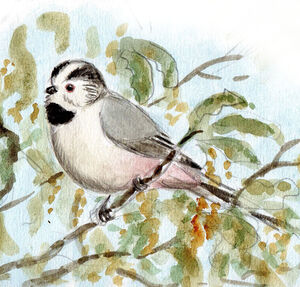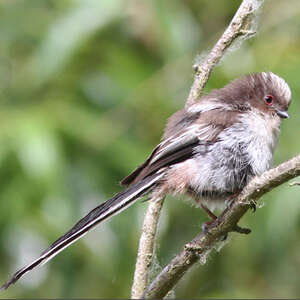Long-tailed Tit
Aegithalos caudatus - Orite à longue queue Mésange à longue queue
Identification
The Long-tailed Tit is a tiny passerine with a compact body, a large round head with small bill, and a very long black and white tail (13-16 cm long, around 6-10 cm of which being the tail, and a weight of 6-10 g). It is precisely this long, graduated tail that means this bird cannot be mistaken for any other. The other tits are from Southeast Asia.
There are 17 subspecies of this species which are spread across Europe and Asia. According to the coloration of the head, the two main European subspecies can be distinguished: the Nordic (Aegithalos caudatus caudatus) which has a purely white head, and the Central European (Aegithalos caudatus europaeus) which has a black band that goes from the bill to the nape, over the eye, and that joins the black mantle. Hybrids between these two subspecies can be distinguished by the incomplete or barely sketched bands. Both the male and female are identical. The wings are black and white. A salmon pink can be seen on the back, the rump, and especially the scapulars. In europaeus the underside are much more pink on the sides, the tummy and the undertail. The throat and chest are white.
The juvenile looks like the adult but is duller and browner, and with less contrast in the plumage. The pink is only present on the scapulars.
Subspecific information 17 subspecies
- Aegithalos caudatus caudatus (n and e Europe to e Siberia, Japan and Korea)
- Aegithalos caudatus rosaceus (British Isles)
- Aegithalos caudatus europaeus (ne France and Germany to n Italy and Turkey)
- Aegithalos caudatus aremoricus (w France)
- Aegithalos caudatus taiti (sw and s France to c Spain and Portugal)
- Aegithalos caudatus irbii (s Spain and Portugal, Corsica)
- Aegithalos caudatus italiae (c and s Italy, sw Slovenia)
- Aegithalos caudatus siculus (Sicily)
- Aegithalos caudatus macedonicus (Albania and Greece to Bulgaria and nw Turkey)
- Aegithalos caudatus tephronotus (e Greece to c Turkey, n Iraq and Syria)
- Aegithalos caudatus tauricus (Crimean Pen.)
- Aegithalos caudatus major (ne Turkey and the Caucasus)
- Aegithalos caudatus alpinus (se Azerbaijan, n Iran and sw Turkmenistan)
- Aegithalos caudatus passekii (se Turkey and sw Iran)
- Aegithalos caudatus trivirgatus (c Japan)
- Aegithalos caudatus kiusiuensis (s Japan)
- Aegithalos caudatus magnus (c and s Korea, Tsushima I.. Japan.)
Foreign names
- Orite à longue queue,
- Mito común,
- chapim-rabilongo-comum,
- Schwanzmeise,
- őszapó,
- Staartmees,
- Codibugnolo,
- stjärtmes,
- Stjertmeis,
- mlynárka dlhochvostá,
- mlynařík dlouhoocasý,
- Halemejse,
- pyrstötiainen,
- mallerenga cuallarga eurasiàtica,
- Skottmeisa,
- raniuszek (zwyczajny),
- garastīte,
- dolgorepka,
- Ополовник,
- エナガ,
- 北长尾山雀,
- stjärtmes,
- 長尾山雀,
Voice song and call
The tsrriiih call of the Long-tailed Tit is distinct and unmistakable. It is a short, rolled call, often repeated in series. There are also tet tet notes between the series. The second important call to know is a repeated sii, three times - sii sii sii - also characteristic. There is no song as such.
Habitat
Its optimal habitat consists of deciduous forests and mixed woodlands of deciduous and coniferous trees, as well as parks and gardens, hedgerows and thickets. It appreciates ecotones and breaks in continuity. It is not a migratory species, and it occupies its sites throughout the year. It is absent from the taiga of Northern Europe and Siberia.
Behaviour character trait
Rarely seen alone, the Long-tailed Tit spends most of its life in a family group. Initially this may consist of 3 or 4 members at the beginning of the breeding season which can grow to 20 or more during the autumn and winter.
Larger groups may include several families. Group members will defend their territory throughout the nesting season as well as during the winter when they feed and sleep there. Although it will wander through woods and along hedgerows in search of food during winter, the Long-tailed Tit rarely travels far and usually stays in the same area for years. While they search for food, bands of Long-tailed Tits are often accompanied by other small woodland birds such as tits of the Parus genus, warblers and other passerines. The Long-tailed Tit's social behaviour helps them survive through the winter months. By huddling together on a branch, fluffed up to conserve heat, they lose as little heat as possible.Dietfeeding habits
The bill of the Long-tailed Tit, short and squat, is too weak to break through resistant or frozen foods.
Therefore, this species mainly feeds on insects, their larvae and eggs, as well as other small invertebrates. With its tiny bill, the tit dislodges its prey from interstices such as the cracks of tree bark. They also pick up insects such as aphids from leaves and buds. Some small soft seeds are consumed, such as those of Japanese spurge and honeysuckle. Unlike true tits, the Long-tailed Tit rarely goes down to the ground to feed, but like them, it can hang upside down or hold its food in one foot. During harsh winters, mortality is high. In the north, tits spend nine tenths of each winter day feeding, travelling great distances without lingering.Reproduction nesting
The Long-tailed Tit differs from other tits by the fact that it doesn't nest in existing cavities, but builds its own cavity from scratch in a tree or bush.
It is one of the best builders amongst birds and despite being one of the smallest birds we have here, it builds a large nest for its size (around 20 cm long and 12 cm wide). It is an oval-shaped, completely closed nest with a side entrance at the top. Building it takes both birds 15-20 days of work. The wall is made of moss and lichens, with a small amount of vegetable fibers, held together by spider web. The outside is covered in lichens so the nest is completely invisible in green surroundings (ivy against a trunk or wall, bushy coniferous branch, etc.). An incredible amount of tiny feathers line the inner cavity. The eggs, 6-12 of them, are incubated by the female alone for 12-13 days. The little tits stay at the nest for 15-18 days before taking off. However, they stay close to their parents and have even been seen helping them later in feeding the young from a second clutch.Geographic range
Threats - protection
IUCN conservation status
concern
in the Wild
threatened
evaluated
The species is common, not globally threatened. Its range is very wide. The decline in Scandinavia is likely due to modern forestry practices and the replacement of ancient habitats with commercial monocultures. In winter, flocks require large territories. Thus, habitat fragmentation and degradation can threaten local populations. Long-tailed Tit is vulnerable to cold winters, which can reduce populations by 80% and return to the previous situation can take years. Predation, particularly by crows, is a major parameter of reproductive success. (Info BirdLife International)
Sources of information
- IOC World Bird List (v15.1), Gill, F and D Donsker (Eds). 2025-12-07.
- An Atlas of the Birds of the Western Palearctic, Colin Harrison
- Les passereaux d'Europe, tome 1, P. Géroudet, M. Cuisin
- Birds of the World, The Cornell Lab of Ornithology
- xeno-canto, Sharing bird sounds from around the world,
Other sources of interest
 Specification sheet created on
28/10/2023 by Didier Collin with help of Georges Olioso
Specification sheet created on
28/10/2023 by Didier Collin with help of Georges OliosoTranslation by AI Oiseaux.net
© 1996-2025 Oiseaux.net
- Accipitriformes
- Aegotheliformes
- Anseriformes
- Apodiformes
- Apterygiformes
- Bucerotiformes
- Caprimulgiformes
- Cariamiformes
- Casuariiformes
- Charadriiformes
- Ciconiiformes
- Coliiformes
- Columbiformes
- Coraciiformes
- Cuculiformes
- Eurypygiformes
- Falconiformes
- Galliformes
- Gaviiformes
- Gruiformes
- Leptosomiformes
- Mesitornithiformes
- Musophagiformes
- Nyctibiiformes
- Opisthocomiformes
- Otidiformes
- Passeriformes
- Pelecaniformes
- Phaethontiformes
- Phoenicopteriformes
- Piciformes
- Podargiformes
- Podicipediformes
- Procellariiformes
- Psittaciformes
- Pterocliformes
- Rheiformes
- Sphenisciformes
- Steatornithiformes
- Strigiformes
- Struthioniformes
- Suliformes
- Tinamiformes
- Trogoniformes


































